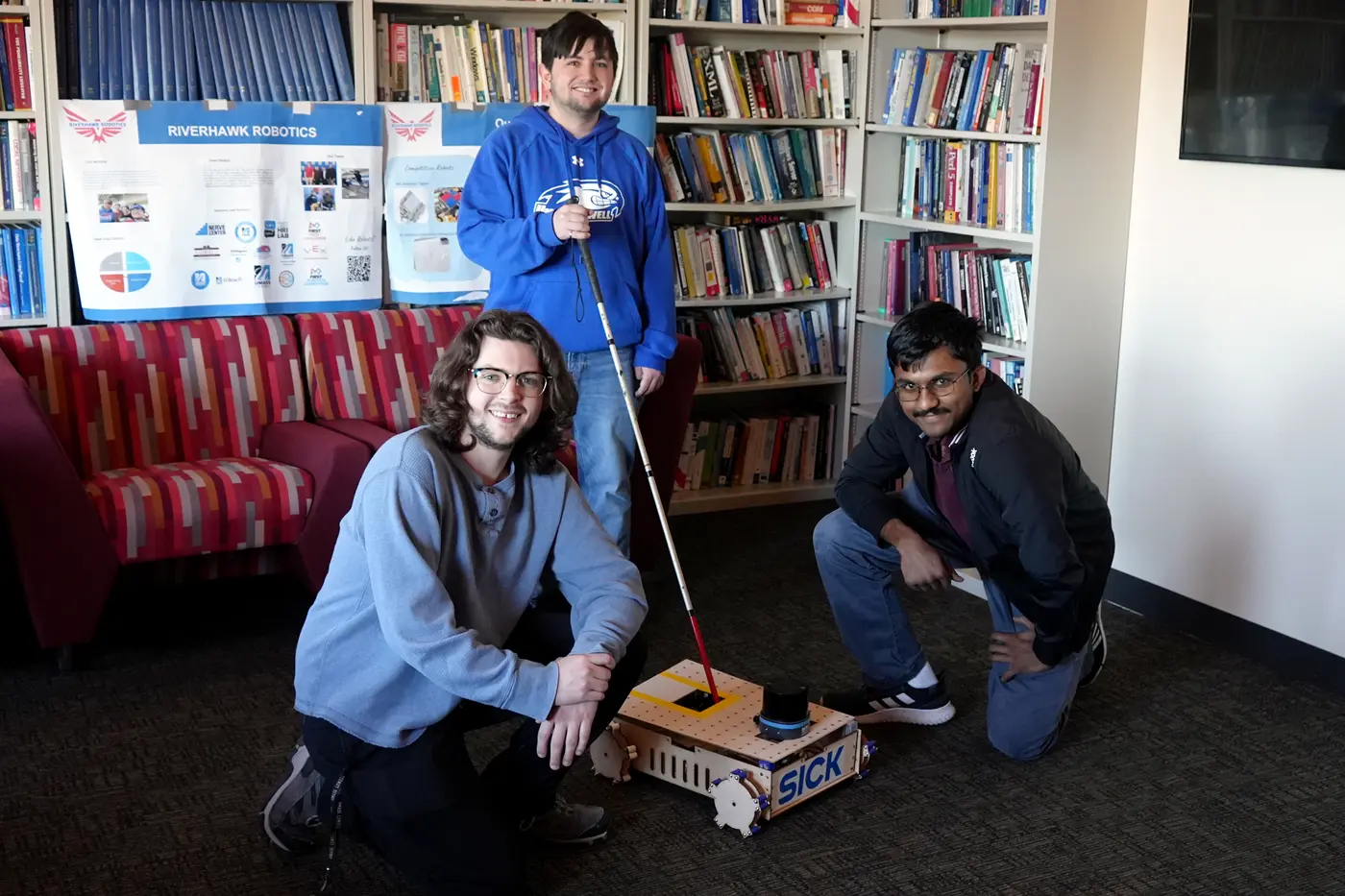 Image by Brooke Coupal
Image by Brooke Coupal
Robotics Club members, from left, Jacob Breen, Trevor Landurand and Sriram Krishnamoorthy showcase their robotic guide dog prototype.
When an optometrist asked Trevor Landurand ’23 to read the letters on an eye chart during the summer following his sophomore year, he responded, “I’m still waiting for the eye chart to go up.”
The optometrist hesitated before saying, “It’s up,” but all Landurand could see was a blank page.
For months, the mechanical engineering major had progressively been losing his eyesight. At first, he thought he might just be overtired, but he was diagnosed with keratoconus, in which the eye’s cornea thins out and bulges like a cone. The condition left Landurand legally blind.
Landurand is now a mechanical engineering master’s student, and he has since gained back most of his vision, thanks to corrective contact lenses and two eye surgeries. That experience has inspired him to help develop a robotic guide dog as a member of the university’s Robotics Club.
“Having this eye condition, I can definitely see this being incredibly useful for those who are visually impaired,” says Landurand, who relied on a walking stick and his dog to get around when his vision was at its worst.
The Robotics Club recently entered a prototype of its robotic guide dog into the SICK $10K Challenge. SICK is a German-based sensor manufacturer that challenges universities across the United States and Canada to use its sensors to solve a problem. UMass Lowell’s Robotics Club was among 15 teams selected for this year's competition. The winning team, which SICK will announce in April, will receive $10,000 for its application of sensor use.
“The money would help us further develop our robot,” says Sriram Krishnamoorthy, a computer engineering senior and the club’s vice president.
As part of the challenge, the Robotics Club received a SICK multiScan100 sensor, which can be used to detect people and objects. With the sensor’s capabilities in mind, Krishnamoorthy came up with the robotic guide dog idea.
 Image by Brooke Coupal
Image by Brooke Coupal
A closer look at the robotic guide dog prototype.
Throughout the development process, the Robotics Club has consulted the Lowell Association for the Blind (LAB).
“As someone who has no visual impairments other than glasses, I need to put my feet in someone else’s shoes to be able to do this project,” says Jacob Breen, a computer science junior and Robotics Club president.
Elizabeth Cannon ’81 has served as the executive director of LAB for 23 years and enjoys collaborating with UMass Lowell students on projects. In the past, she’s helped students develop shoes and sleeves that alerted people when they came close to an object. Cannon has also hired dozens of interns from UMass Lowell and has worked with classes to bring awareness about blindness through events such as “Dining in the Dark” and lessons on using a cane.
“We have a great relationship with the university,” she says.
Cannon offered advice to the students as they developed their project: Make the technology easy to use, ensure the robot is stable on the ground and can climb stairs, and program it so it can navigate unfamiliar buildings and guide people to the appropriate rooms. The Robotics Club plans to bring its invention to LAB for people with visual impairments to test.
“It’s one thing to design a product when you have preconceived ideas about what the need is, but when they meet people that would have to rely on the product, I think that will be a real eye-opener for them,” she says. “Getting feedback will be helpful for their process.”
Another factor that the Robotics Club is taking into account is the cost. A living guide dog can cost up to $50,000 annually for training and care. The team is aiming to build its robot for one-fifth of that annual price.
“We want to be able to provide a more affordable option,” Breen says.
 Image by Brooke Coupal
Image by Brooke Coupal
The SICK multiScan100 sensor can be used to detect people and objects.
The students designed their robotic guide dog so a person using a mobility cane can place it into the top of the robot to use as a handle. The robot itself sits low to the ground to ensure stability and sports customized wheels that can climb curves and stairs while remaining in place when the robot is not in motion. The prototype is made of wood with steel support beams, but the team plans on making a final version out of aluminum. The multiScan100 sits atop the robot and emits light waves from a laser to detect objects.
“The sensor is like an eyeball,” Breen says. “It takes in light that’s reflected off of different surfaces and then, like a brain, it interprets it with the help of a computer and a bit of artificial intelligence.”
The Robotics Club also outfitted the robot with depth-sensing cameras to enhance its object detection ability. The students plan on adding a GPS location device that would transmit data to a website, so people can track the locations of their loved ones. The website would also gather information from the sensor and cameras, giving people the ability to see a depth map of the terrain that their loved ones have crossed.
In the future, the team intends to develop a way for the robot to guide people to specific rooms. This would help prevent the user from getting lost when, for instance, they are looking for room 327 in a hospital.
The Robotics Club sees a promising future for its robotic guide dog, which the members have also entered into the Rist DifferenceMaker Institute’s $50K Idea Challenge, to be held on April 10.
“It’s been exciting to see this robot come together,” Landurand says. “To be able to help people going forward is just awesome.”
